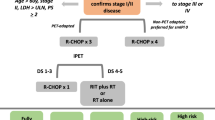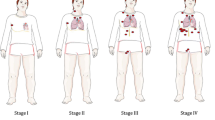Abstract
Residual disease in patients with diffuse large B-cell lymphoma after intensive chemotherapy remains a problem. Radiotherapy has been used in some retrospective studies without definitive conclusions. We report the first controlled clinical trial to define the role of radiotherapy in this setting of patients. One hundred and sixty-six patients with diagnosis of diffuse large B-cell lymphoma, high- or high-intermediate clinical risk, with residual disease (defined as tumor mass <5 cm) were randomly assigned to received radiotherapy at the involved field, with 30 Gy delivered in 20 sessions or no radiation (control group). Median follow-up was 135 mo; patients who received radiotherapy have an better outcome. Actuarial curves at 10 yr showed that progressive-free disease was 86% and overall survival was 89%; those were statistical significant when compared to patients who did no received radiotherapy: 32% and 58% respectively, (p<0.001). Toxicity was mild and well tolerated. We concluded that presence of residual mass after chemotherapy in patients with aggressive malignant lymphoma has a worse prognosis, and salvage radiotherapy improves outcome with mild toxicity. We feel that radiotherapy will be considered as necessary treatment in this special group of patients.
Similar content being viewed by others
References
Haq R, Swaks CA, Franserro E, Beristein NL. Significance of a partial or slow response to front line chemotherapy in the management of intermediate- and high-grade non-Hodgkin’s lymphoma. A literature review. J Clin Oncol 1994;12:1074–1084.
Schlembach PJ, et al. Impact of involved field radiotherapy after CHOP-based chemotherapy on stage III-IV intermediate grade and large-cell immunoblastic lymphoma. Int J Radiat Oncol Biol Phys 2000; 48:1107–1110.
Rodriguez-Catarino M, Jerkeman M, Ahltröm H, Grimelius B, Hagberg H. Residual mass in aggressive lymphoma due size measured from computed tomography influence clinical outcome. Acta Oncol 2000; 39:485–489.
Nieder C, Licht T, Andratschke P, Peschel C, Molls M. Influence of differing radiotherapy strategies on treatment results in diffuse large cell lymphoma. Cancer Treat Rev 2003; 29:11–19.
Wilder RB, et al. Dose-response analysis for radiotherapy delivered to patients with intermediate-grade and large cell immunoblastic lymphoma that have completely response to CHOP-based chemotherapy. Int J Radiat Oncol Biol Phys 2001; 49:17–22.
Wilder RB, et al. Radiation therapy after a partial response to CHOP chemotherapy for aggressive lymphomas. Int J Radiat Oncol Biol Phys 2001; 50:743–749.
Fuller LM, et al. Significance of tumor size and radiation dose to local control in stage I–III diffuse large cell lymphoma treated with CHOP-Bleo and radiation. Int J Radiat Oncol Biol Phys 1995; 31:3–11.
Aviles A, et al. Adjuvant radiotherapy to sites of previous bulky disease in patients with stage IV diffuse large cell lymphoma. Int J Radiat Oncol Biol 1994; 30:799–804.
Aviles A, et al. Adjuvant radiotherapy in stage IV diffuse large cell lymphoma improve outcome. Leuk Lymph 2004; 45:1385–1389.
Miller TP, et al. Chemotherapy alone compared with chemotherapy plus radiotherapy for localized intermediate and high grade non Hodgkin’s lymphoma. N Engl J Med 1998; 339:21–26.
Zinzani PL, et al. MACOP-regimen followed by involved field radiation therapy in early stage aggressive non-Hodgkin’s lymphoma. Leuk Lymph 2001; 42:989–995.
Van der Maazen RWM, et al. Combined modality therapy is the treatment of choice for stage I/IE intermediate and highgrade non-Hodgkin’s lymphoma. Radiather Oncol 1998; 49:1–7.
Krul ADG, et al. Cyclophosphamide, doxorubicin, vincristine and prednisone chemotherapy and radiotherapy for stage I intermediate or high grade non Hodgkin’s lymphoma. Radiather Oncol 2001; 58:251–255.
Aviles A, et al. Combined therapy in the treatment of primary mediastinal B-cell lymphoma. Ann Hematol 2002; 88:368–373.
Zinzani PL, et al. Treatment and clinical management of primary mediastinal large B-cell lymphoma with sclerosis. MACOP-B regimen and mediastinal radiation therapy monitored by 67 gallium scan in 50 patients. Blood 1999; 94:3289–3293.
Oguchi M, et al. Tumor bulk as a prognostic factor for the management of localized aggressive non-Hodgkin’s lymphoma. A survey of the Japanase Lymphoma Radiation Therapy Group. Int J Radiat Oncol Biol Phys 2001; 48:161–168.
Ferreri AJM, et al. Consolidation radiotherapy to bulky or semibulk lesions in the management of stage III–IV diffuse large cell lymphoma. Oncology 2000; 58:219–226.
Cosset JM, et al. An alternating chemotherapy and radiotherapy combination for non-Hodgkin’s lymphomas of unfavourable histologies. Radiother Oncol 1988; 3:133–138.
Jerusalem G, et al. Wholy-body positron emission tomography using 18F-fluyorodeoxiglucose for postreatment evaluation in Hodgkin’s disease and non-Hodgkin’s lymphoma has higher diagnostic and prognostic value that classical computed tomography scan imaging. Blood 1999; 94:429–433.
Bangerter M, et al. Positron-emission tomography with 18-fluoridedeoxiglucose in the staging and follow-up of lymphoma in the chest. Acta Oncol 1999; 38:799–804.
Author information
Authors and Affiliations
Corresponding author
Rights and permissions
About this article
Cite this article
Avilés, A., Neri, N., Delgado, S. et al. Residual disease after chemotherapy in aggressive malignant lymphoma. Med Oncol 22, 383–387 (2005). https://doi.org/10.1385/MO:22:4:383
Received:
Accepted:
Issue Date:
DOI: https://doi.org/10.1385/MO:22:4:383




